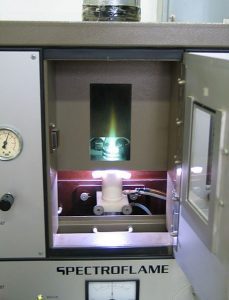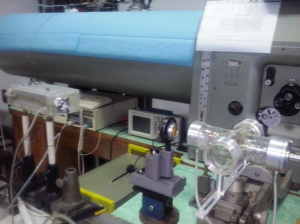FIELD OF RESEARCH / THE RESEARCH GROUP’S NAME
Atomic spectrochemistry and physical chemistry of plasma
SHORT DESCRIPTION OF RESEARCH
The group is involved in the investigation and development of new excitation sources for quantitative spectrochemical analysis. Our research interests include the designing of plasma sources, plasma diagnostics, investigation of basic mechanisms related to analyte excitation, balances and transport properties in the plasma, and analytical applications of plasma spectrometry.
Part of our research efforts are devoted to the investigation of atmospheric pressure direct current (dc) argon arc plasma. Research topics include investigation and modelling of factors affecting the analyte transport and excitation, the influence of the radial electric field on penetration of analyte atoms into the hottest plasma core, the influence of the presence of easily ionized elements and penetration of molecular gases on the characteristics of arc plasma, and spectrochemical matrix effects. The radial electric field, which depends on plasma composition and the arc current, plays a decisive role in limitation of dc arc analytical capabilities. A possibility for improving the spectrochemical characteristics of arc discharge using the power modulation technique is also investigated.
Our recent research interest is focused on a novel technique for elemental analysis based on laser-generated plasma, laser induced breakdown spectroscopy (LIBS). Growing interest in spectrochemical application of LIBS is due to its unique features like versatility, simplicity, speed of analysis and capacity of non-contact and remote measurement. In addition, LIBS may be used with a minimum of sample preparation for multi-elemental identification and analysis of all sample types. A unique LIBS system based on Transversally Excited Atmospheric (TEA) CO2 laser and time-integrated, spatially-resolved detection has been developed. Compared to commonly used LIBS systems based on Nd:YAG laser and time-gated detection, the main advantage of the TEA CO2 laser based LIBS is reduced complexity and cost of the instrumentation. We have studied the influence of different experimental parameters (laser energy, spot focusing, composition and pressure of the background gas, sample surface characteristics, etc.) on the analytical performance of our LIBS system. The system was optimized and applied to the analysis of various sample types: metals and metal alloys, geological samples, powdered biological samples and mineral pigments. Currently under investigation is the applicability of TEA CO2 laser based LIBS for the analysis of molecular emission and isotope analysis. Spectral emission of small molecules (CN, C2) is of special interest as it may be used for plasma diagnostics. Molecular LIBS has a potential for development of specific applications like detection and monitoring of organic pollutants or analysis of complex pharmaceutical products.
THE MEMBERS OF RESEARCH GROUP
- Dr Miroslav Kuzmanović, Asociate Proffesor
- Dr Dragan Ranković, Research Associate
SCIENTIFIC EQUIPMENT
- ISP spectrometer Spectroflame

- Spectrograph PGS – 2

- AAS spectrometer Varian 775
COOPERATION AND PROJECTS
- Dr Miroslav Kuzmanović and dr Dragan Rankovic are members of the Group “Laser physical chemistry and optical spectroscopy” of the Laboratory for Physical Chemistry of the Institute “Vinča”, which is led by research professor dr Milan Trtica.
- Dr Miroslav Kuzmanović and dr Dragan Rankovic are working on a project funded by the Ministry of Education, Science and Technological Development: “Effects of laser radiation and plasma on novel materials in their synthesis, modification and analysis”, which is led by research professor dr Milan Trtica.
SELECTED PUBLICATIONS
- J.Savovic, S.Zivkovic, M.Momcilovic, M.Trtica, M.Stoiljkovic, M.Kuzmanovic, “Determination of low alloying element concentrations in cast iron by laser induced breakdown spectroscopy based on TEA CO2 laser system”, Journal of the Serbian Chemical Society (2017), in press
- J.Savovic, M.Momcilovic, S.Zivkovic, A.Stancalie, M.Trtica, M.Kuzmanovic, “LIBS analysis of geo-materials: Comparative study of basalt plasma induced by TEA CO2 and Nd:YAG laser in air at atmospheric pressure”, J.Chem (Hidawi), Volume 2017 (2017), Article ID 9513438, 9 pages. https://doi.org/10.1155/2017/9513438
- J.Savovic, M.Stoiljkovic, M.Kuzmanovic, M.Momcilovic, J.Ciganovic, D.Rankovic, S.Zivkovic, M.Trtica, “The feasibility of TEA CO2 laser-induced plasma for spectrochemical analysis of geological samples in simulated Martian conditions”, SpectrochimicaActa, Part B: Atomic Spectroscopy (2016), 118B, 127-136.
- J.Ciganovic, S.Zivkovic, M.Momcilovic, J.Savovic, M.Kuzmanovic, M.Stoiljkovic, M.Trtica, “Laser-induced features at titanium implant surface in vacuum ambience”, Opt. Quant. Electron.(2016) 48:133
- D.Rankovic, J.Savovic, M.Kuzmanovic, M.Stoiljkovic, “Properties of argon-nitrogen atmospheric pressure DC arc plasma”, Plasma Chemistry and Plasma Processing, (2015), vol. 35 1071-1095.
- M.Momcilovic, M.Kuzmanovic, D.Rankovic, J.Ciganovic, M.Stoiljkovic, J.Savovic,M.Trtica, “Optical emission studies of Cu plasma induced byIR TEA CO2 laser pulses”, Applied Spectroscopy (2015), (2015) vol. 69 419-429.
- M.Kuzmanovic, M.Momcilovic, J. Ciganovic, D. Rankovic, J. Savovic, D. Milovanovic, M. Stoiljkovic, M.S. Pavlovic and M. Trtica, “Properties of plasma induced by pulsed CO2 laser on a copper target under different ambient conditions”, PhysicaScripta T(2014), vol. T162
- R.Laher, M.Khakoo, M. Kuzmanović, A.Antić-Jovanović, “Reinvestigation of the Electronic Transition Moment Function of the BO B2Σ+ – X2Σ+Band System”, Journal of Quantitative Spectroscopy &RadiativeTransfer (2014), vol140 67-74.
- A. Antic-Jovanović, M.Kuzmanović, M.Khakoo, R.Laher, ”Franck-Condon simulation of the B–A bands of BO1”,Russian Journal of Physical Chemistry A, (2013), vol. 87 br. 13, str. 2225-2230.
- M.D. Momcilovic, M.S. Trtica, J. Ciganovic, J.J. Savovic, J.M. Stasic, M.M. Kuzmanovic, “Analysis of copper surface features obtained using TEA CO2 laser at reduced air pressure”, Applied Surface Science (2013), vol. 270, str. 486-494.
